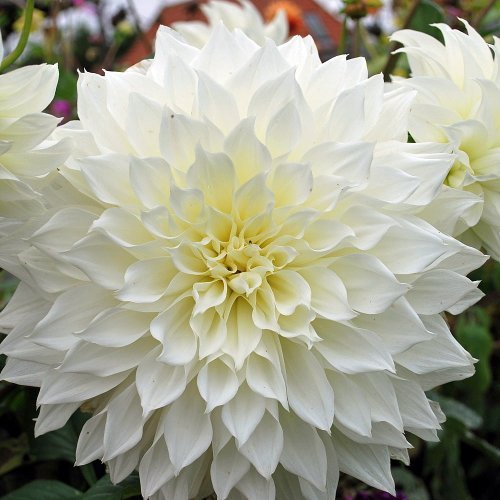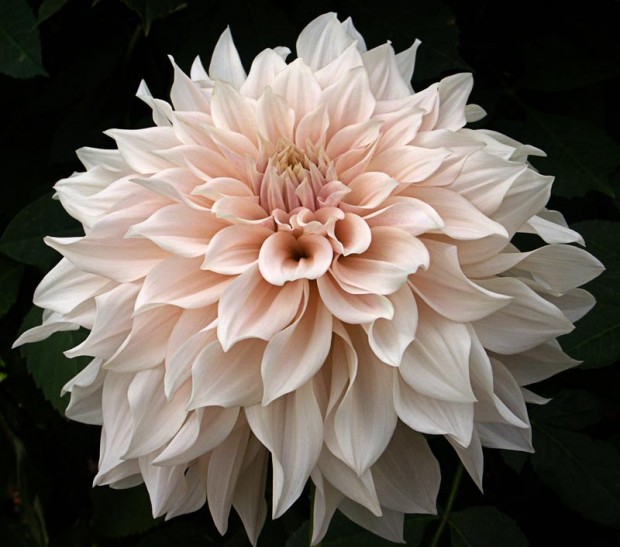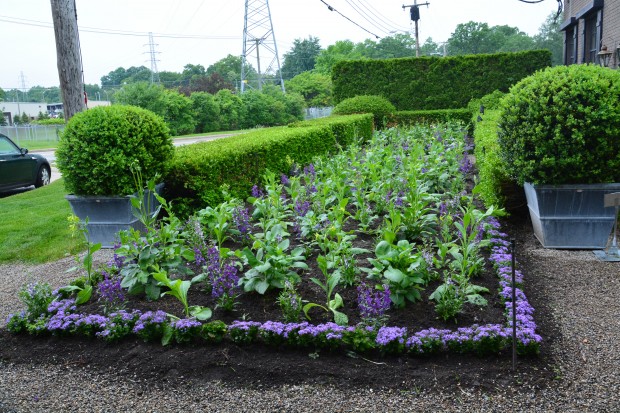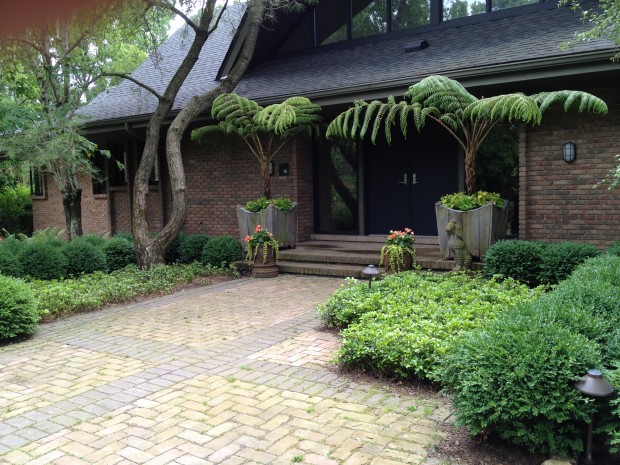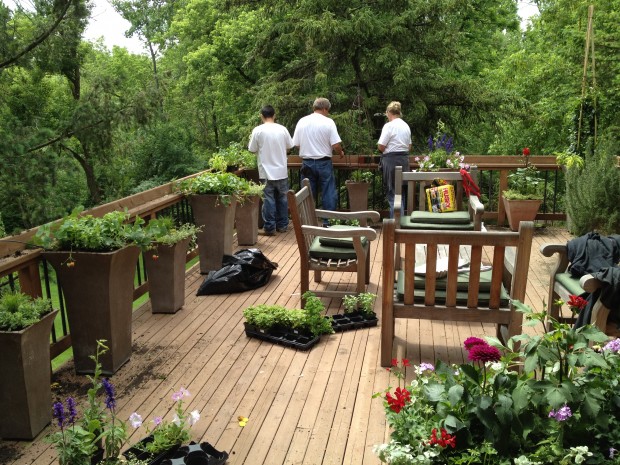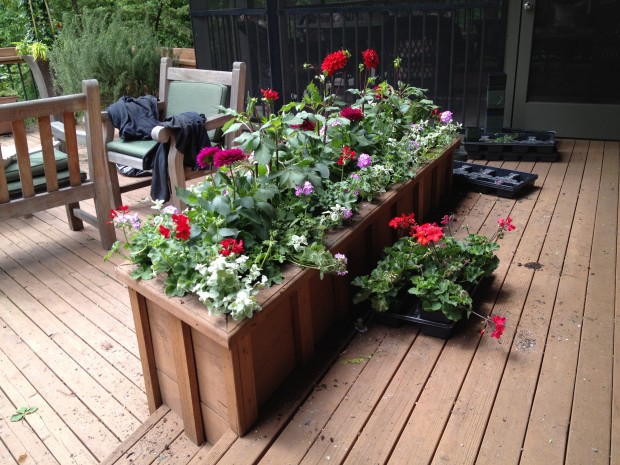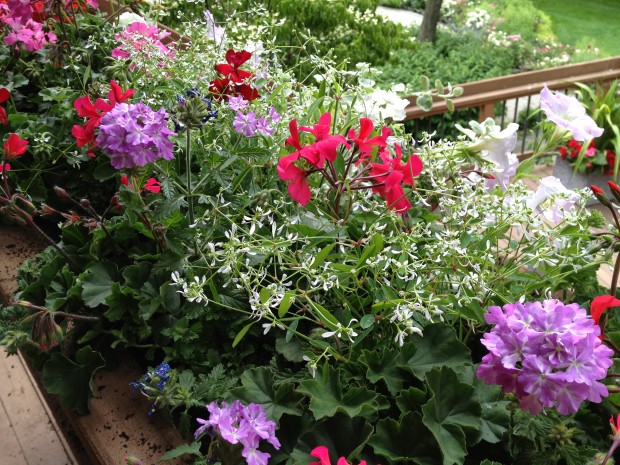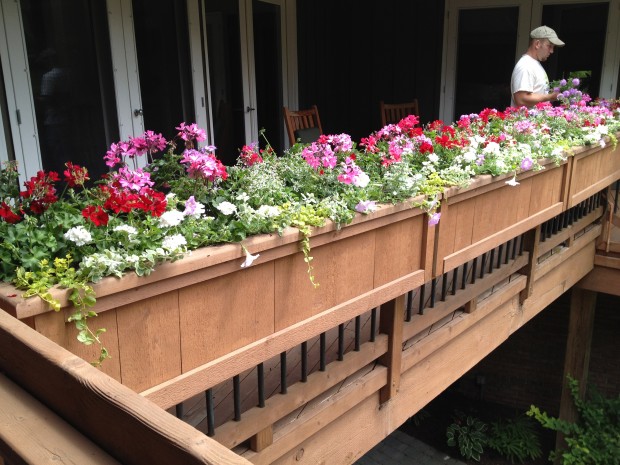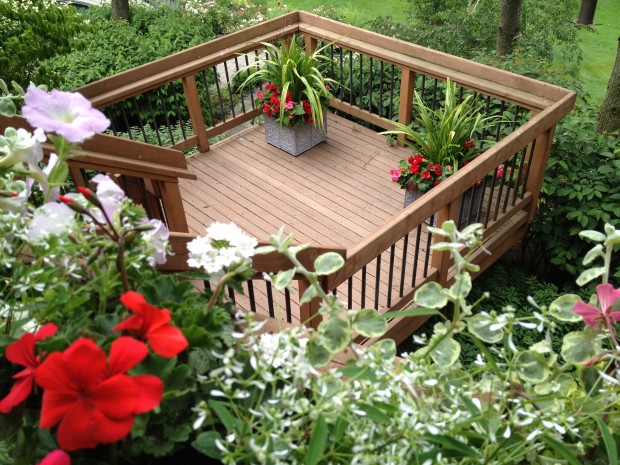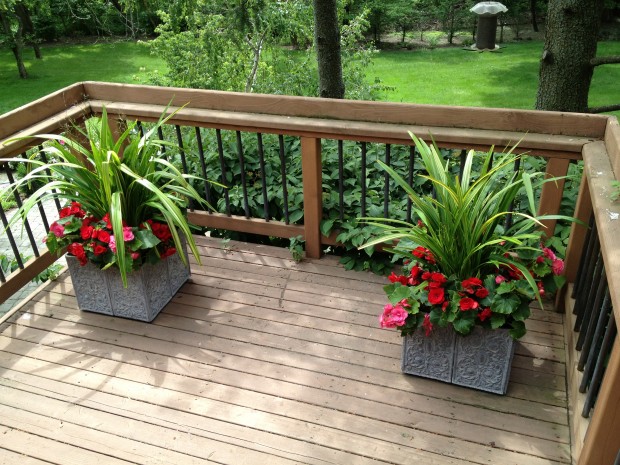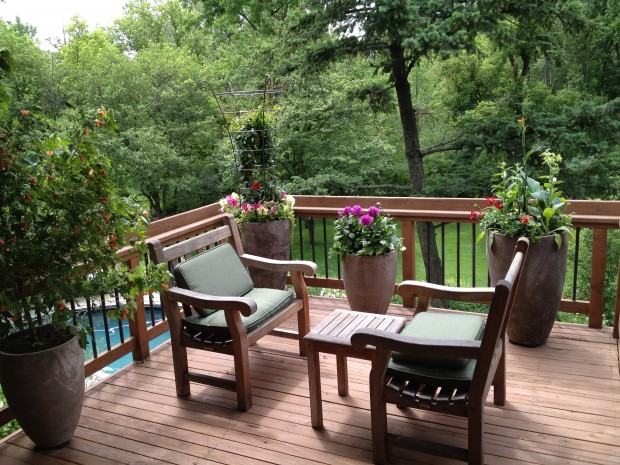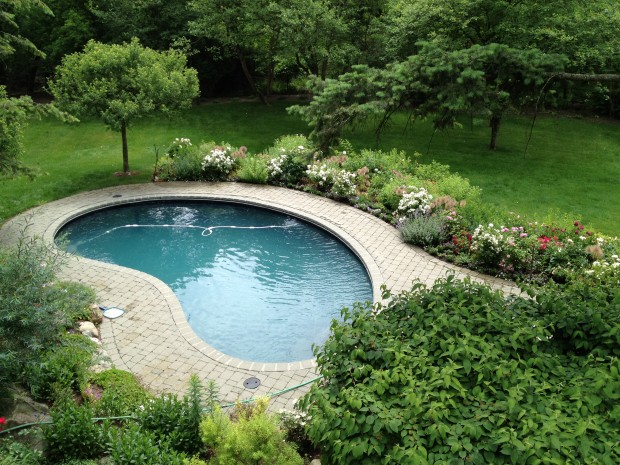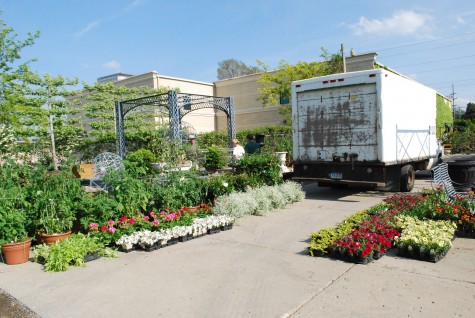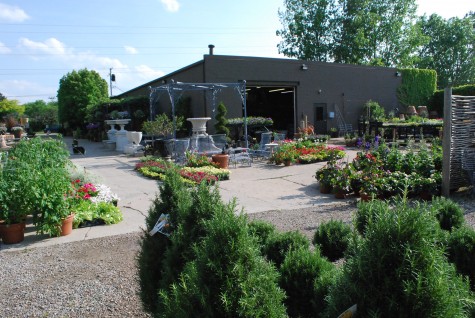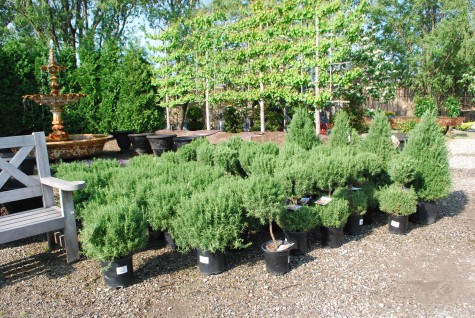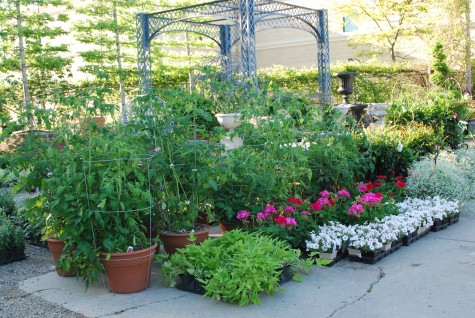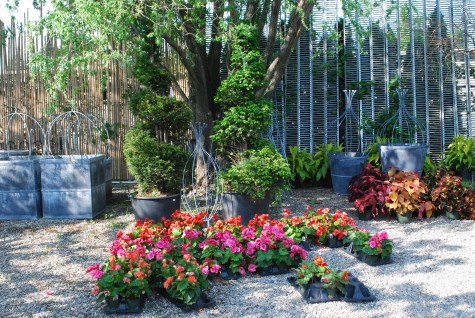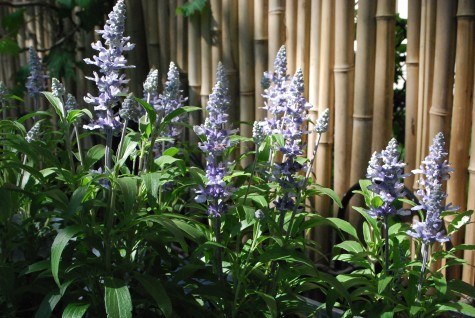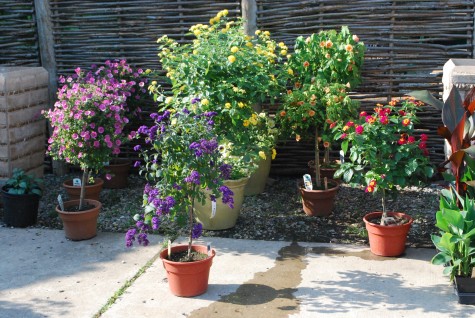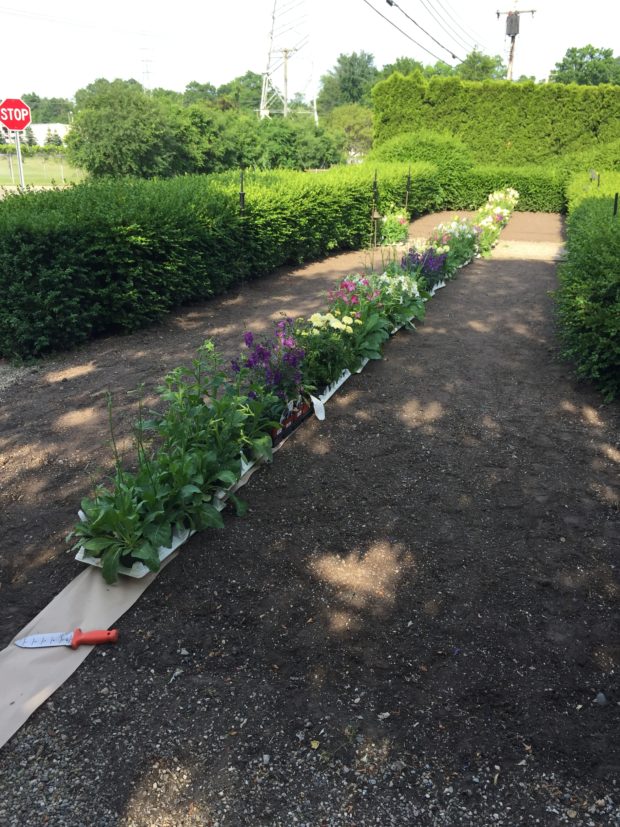 No matter how many container plantings we do in a given year, planting the shop for the summer is a given planting. I put this close to home project off until the great majority of our clients are planted. Some might think that I take the winter to plan what I will do in the summer shop garden, but I do not. Once we start bringing in annual plants for sale, I keep looking until something triggers a decision. Rob plants a lot of containers for the shop, and this year’s collection is especially good. I could characterize how he composes and plants in the following way. He favors green above all, but lavender, rosemary, and all the the herbs to go with run a close second. He gravitates towards annual plants that are relaxed in habit and subdued in color. A wood box may be filled from start to finish with Grosso lavender. An Italian terra cotta pot may feature a Malabar spinach vine trailed up a rusted rod steel sphere. A vintage galvanized steel trough might be planted with tomatoes and herbs. Slatted wood boxes lined with coir, and planted with verbena bonariensis, peach dahlias and pale yellow marguerites are as casually elegant as they are unstudied. His shade container with bird’s nest ferns and selaginella fly out the door. All of his container plantings are reserved. His touch is light. This year’s shop planting is in admiration and recognition of that work. My idea in the big planting bed was to plant a collection of summer blooming annuals in mixed colors, in a a random and relaxed pattern. Nothing too flashy or fussy; think cream colored marigolds. A strip of brown paper towel down the center of the bed would establish a no plant zone. Weeding a wayward and unstudied planting asks for access.
No matter how many container plantings we do in a given year, planting the shop for the summer is a given planting. I put this close to home project off until the great majority of our clients are planted. Some might think that I take the winter to plan what I will do in the summer shop garden, but I do not. Once we start bringing in annual plants for sale, I keep looking until something triggers a decision. Rob plants a lot of containers for the shop, and this year’s collection is especially good. I could characterize how he composes and plants in the following way. He favors green above all, but lavender, rosemary, and all the the herbs to go with run a close second. He gravitates towards annual plants that are relaxed in habit and subdued in color. A wood box may be filled from start to finish with Grosso lavender. An Italian terra cotta pot may feature a Malabar spinach vine trailed up a rusted rod steel sphere. A vintage galvanized steel trough might be planted with tomatoes and herbs. Slatted wood boxes lined with coir, and planted with verbena bonariensis, peach dahlias and pale yellow marguerites are as casually elegant as they are unstudied. His shade container with bird’s nest ferns and selaginella fly out the door. All of his container plantings are reserved. His touch is light. This year’s shop planting is in admiration and recognition of that work. My idea in the big planting bed was to plant a collection of summer blooming annuals in mixed colors, in a a random and relaxed pattern. Nothing too flashy or fussy; think cream colored marigolds. A strip of brown paper towel down the center of the bed would establish a no plant zone. Weeding a wayward and unstudied planting asks for access.
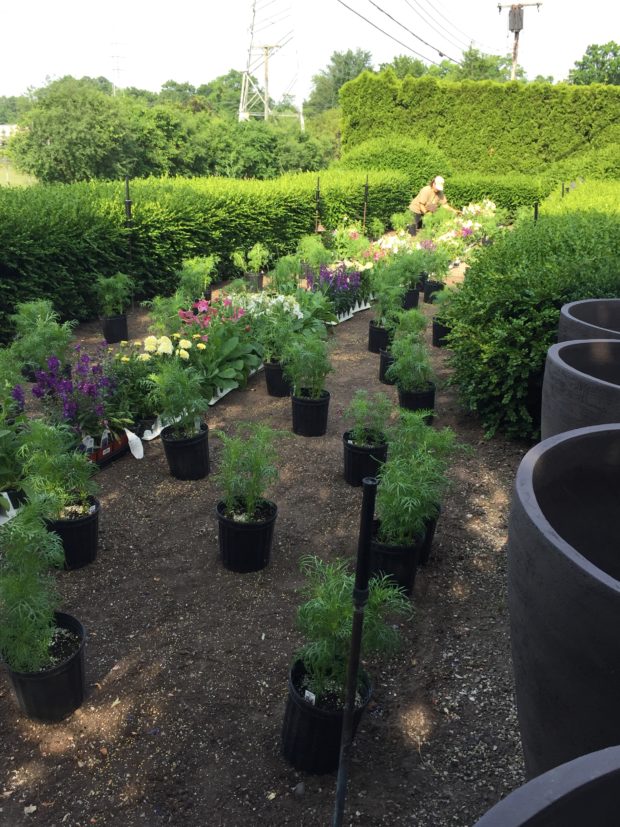 This planting is dominated by 70 some 1 gallon pots of Sonata cosmos. Of course we laid out those cosmos first. As casually as we imagined Rob would place them. We had no idea if the pots were mixed colors, or a single color. Next to come, lots of the airy growing nicotiana suaveolens, nicotiana perfume bright rose, lime and white, a few purple angelonia, and cream white marigolds. None of these plants truly meadowy-these are all hybrid tropical plants. But mixed in a casual way. It took my crew all of five minutes to grasp the idea. In less than 2 hours, we had a garden. I am sure Rob would have never plant the nicotiana Perfume Bright Rose-that was my idea.
This planting is dominated by 70 some 1 gallon pots of Sonata cosmos. Of course we laid out those cosmos first. As casually as we imagined Rob would place them. We had no idea if the pots were mixed colors, or a single color. Next to come, lots of the airy growing nicotiana suaveolens, nicotiana perfume bright rose, lime and white, a few purple angelonia, and cream white marigolds. None of these plants truly meadowy-these are all hybrid tropical plants. But mixed in a casual way. It took my crew all of five minutes to grasp the idea. In less than 2 hours, we had a garden. I am sure Rob would have never plant the nicotiana Perfume Bright Rose-that was my idea.
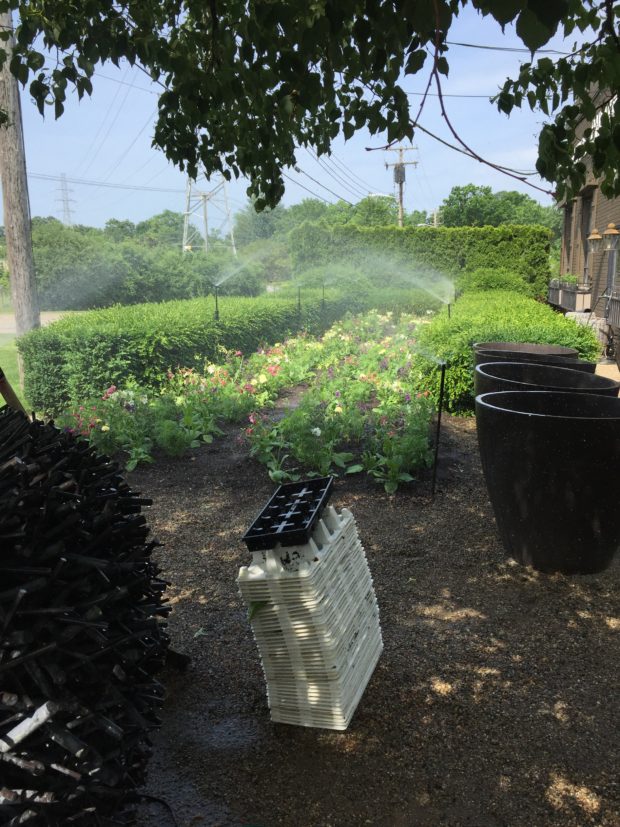 Once every plant was in the ground, we watered, and watered again. Watering new plantings is nearly a daily job. Hot weather can be deadly to a plant that has not yet rooted into the surrounding soil. Many annual plants are grown in soilless mixes. Once that small rootball dries out, look out. Annual plants in the ground or in containers regularly watered with take hold and thrive. Once established, sun loving annual plants are remarkably unfazed by dry soil.
Once every plant was in the ground, we watered, and watered again. Watering new plantings is nearly a daily job. Hot weather can be deadly to a plant that has not yet rooted into the surrounding soil. Many annual plants are grown in soilless mixes. Once that small rootball dries out, look out. Annual plants in the ground or in containers regularly watered with take hold and thrive. Once established, sun loving annual plants are remarkably unfazed by dry soil.
 Regular rain and moderate temperatures early in the growing season resulted in a dramatic spring flush on the boxwood. We have held off pruning, as our current temperatures have been in the high eighties. Next week is slated to be much cooler, and Melissa and her crew will prune. A gently geometric pruning will provide a pleasing contrast to the planting.
Regular rain and moderate temperatures early in the growing season resulted in a dramatic spring flush on the boxwood. We have held off pruning, as our current temperatures have been in the high eighties. Next week is slated to be much cooler, and Melissa and her crew will prune. A gently geometric pruning will provide a pleasing contrast to the planting.
 New this year- we covered the entire planting with a mulch of ground bark fines. This will help conserve moisture in the soil, and discourage weeds, although who knows. Maybe the weeds will look good with the planting. Decades of professional gardening and maintenance has made me a weed pulling, plant staking, dead heading, raking and wash down the driveway kind of gardener. When I say nature bats last, I am also saying that this gardener bats in the clean up position. Having just turned 67, I doubt I will be making any substantial changes to the way I work. This planting is not what I would have done, left to my own devices. But having done it, I will try to leave it be, and see what happens.
New this year- we covered the entire planting with a mulch of ground bark fines. This will help conserve moisture in the soil, and discourage weeds, although who knows. Maybe the weeds will look good with the planting. Decades of professional gardening and maintenance has made me a weed pulling, plant staking, dead heading, raking and wash down the driveway kind of gardener. When I say nature bats last, I am also saying that this gardener bats in the clean up position. Having just turned 67, I doubt I will be making any substantial changes to the way I work. This planting is not what I would have done, left to my own devices. But having done it, I will try to leave it be, and see what happens.
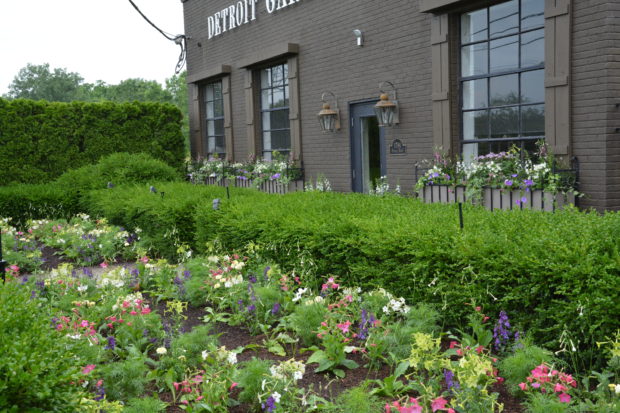 The window boxes have a similar feeling, but include some plants not in the ground garden. Dwarf cleome, sky blue petunias, variegated sage and white trailing verbena have been added to the mix.
The window boxes have a similar feeling, but include some plants not in the ground garden. Dwarf cleome, sky blue petunias, variegated sage and white trailing verbena have been added to the mix.
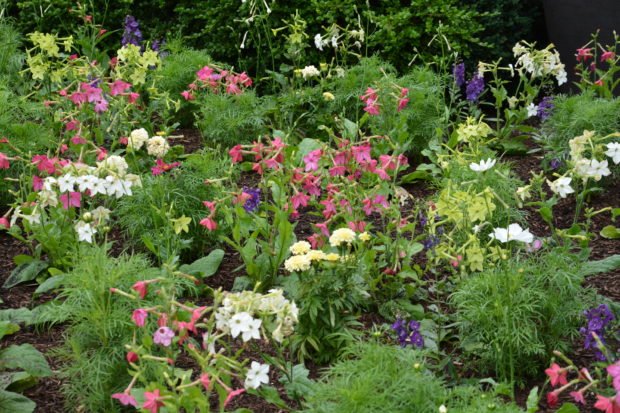 But for that far too bright rose pink nicotiana, this has something of the feeling of Rob’s compositions.
But for that far too bright rose pink nicotiana, this has something of the feeling of Rob’s compositions.
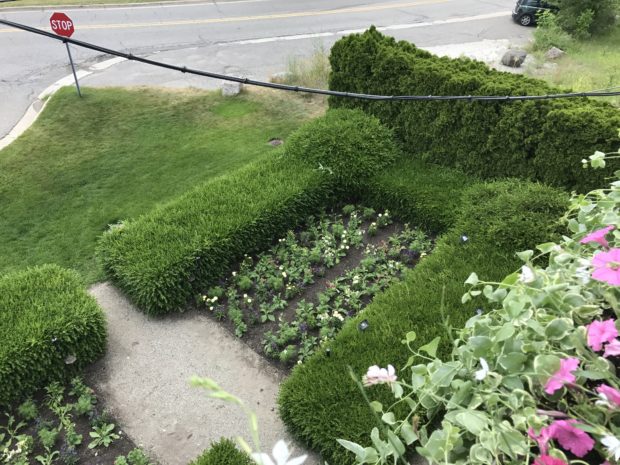 Those of you who are able to visit Detroit Garden Works know that we have galvanized metal planter boxes that traverse the entire length of the roof that faces our street. From this vantage point, it is easy to see that the boxwood has at least 8 inches of new growth. It will take Melissa and her crew all day to prune it. The plants chosen for the garden are in the 24″ high range. The garden will not be visible from the street. To see it, you will have to walk up the driveway and look in. I have always planted this garden taller than the boxwood. Why? Tradition, for good or for ill. This hedge is now in its 20th year, and despite the ravages of two really terrible winters, is quite something in its own right. It will be the star of the summer show, especially given that both the composition and plant choices are plain and simple. Metaphorically speaking, my gardens usually wear shoes and socks. This garden is decidedly less formal than that.
Those of you who are able to visit Detroit Garden Works know that we have galvanized metal planter boxes that traverse the entire length of the roof that faces our street. From this vantage point, it is easy to see that the boxwood has at least 8 inches of new growth. It will take Melissa and her crew all day to prune it. The plants chosen for the garden are in the 24″ high range. The garden will not be visible from the street. To see it, you will have to walk up the driveway and look in. I have always planted this garden taller than the boxwood. Why? Tradition, for good or for ill. This hedge is now in its 20th year, and despite the ravages of two really terrible winters, is quite something in its own right. It will be the star of the summer show, especially given that both the composition and plant choices are plain and simple. Metaphorically speaking, my gardens usually wear shoes and socks. This garden is decidedly less formal than that.
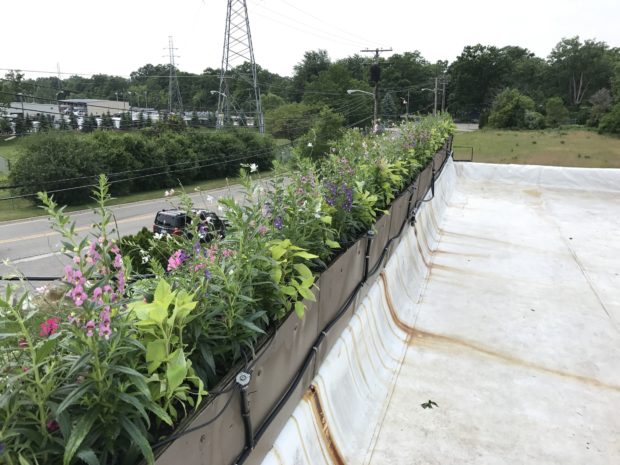 But back up to the roof garden. The boxes were made to sit on the parapet wall that runs across the front. They are outfitted with irrigation, as climbing up here, hose in hand, requires a substantial extension ladder and no small amount of nerve. It is a hot and windy place. The boxes hold 3 rows of plants. The back row is planted with the lemon lime leaved pineapple sage, and a new white, pink and blue angelonia. This hybrid has very thick stems, and was originally developed for the cut flower trade. Both of these plants like full sun and heat. This new angelonia is reputed to grow 40″ tall. If it does, this row of plants will help to mitigate the effects of the wind for all.
But back up to the roof garden. The boxes were made to sit on the parapet wall that runs across the front. They are outfitted with irrigation, as climbing up here, hose in hand, requires a substantial extension ladder and no small amount of nerve. It is a hot and windy place. The boxes hold 3 rows of plants. The back row is planted with the lemon lime leaved pineapple sage, and a new white, pink and blue angelonia. This hybrid has very thick stems, and was originally developed for the cut flower trade. Both of these plants like full sun and heat. This new angelonia is reputed to grow 40″ tall. If it does, this row of plants will help to mitigate the effects of the wind for all.
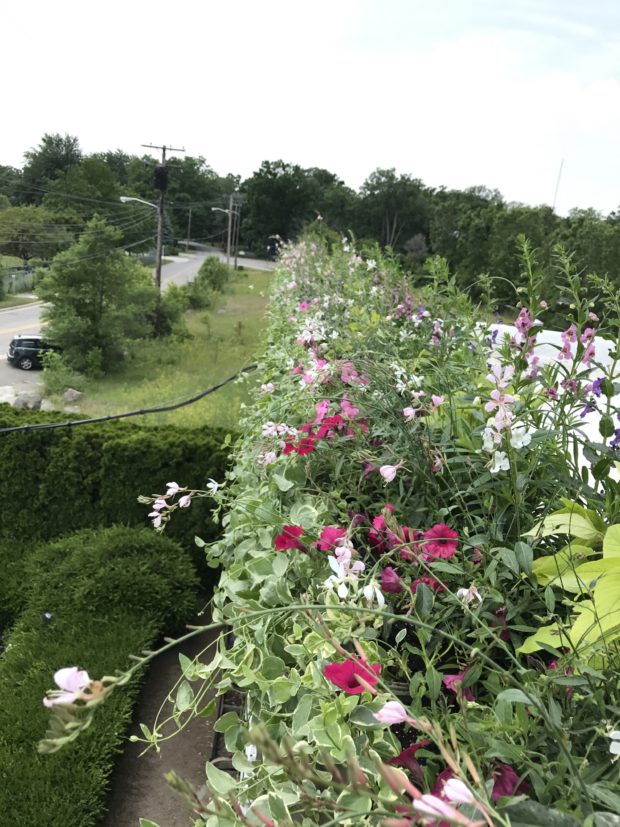 The middle row is comprised of 3 colors of vista petunias, interspersed with white and pink Gaura. The white tinged pink petunia cultivar “Silverberry” was planted in the two center boxes. Then moving towards the edges on both sides, Vista “Bubblegum”, and finally Vista “Fuchsia”. Petunias are the one of the most ordinary annual plants, but this cultivar is a vigorous grower seldom bothered by any problems. We try to stay away from problems on the roof. In the front row, a thick planting of the annual white variegated vinca vine.
The middle row is comprised of 3 colors of vista petunias, interspersed with white and pink Gaura. The white tinged pink petunia cultivar “Silverberry” was planted in the two center boxes. Then moving towards the edges on both sides, Vista “Bubblegum”, and finally Vista “Fuchsia”. Petunias are the one of the most ordinary annual plants, but this cultivar is a vigorous grower seldom bothered by any problems. We try to stay away from problems on the roof. In the front row, a thick planting of the annual white variegated vinca vine.
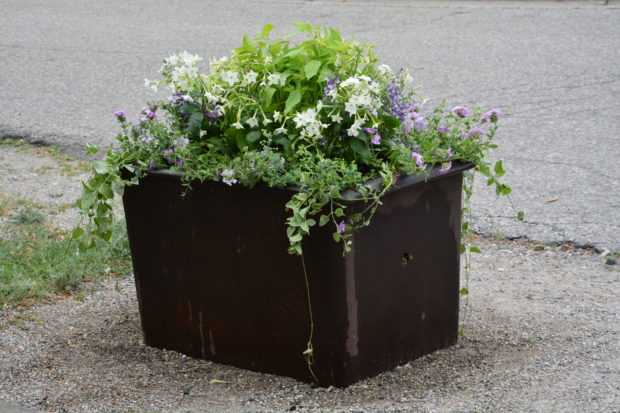 We are ready just in time for summer.
We are ready just in time for summer.
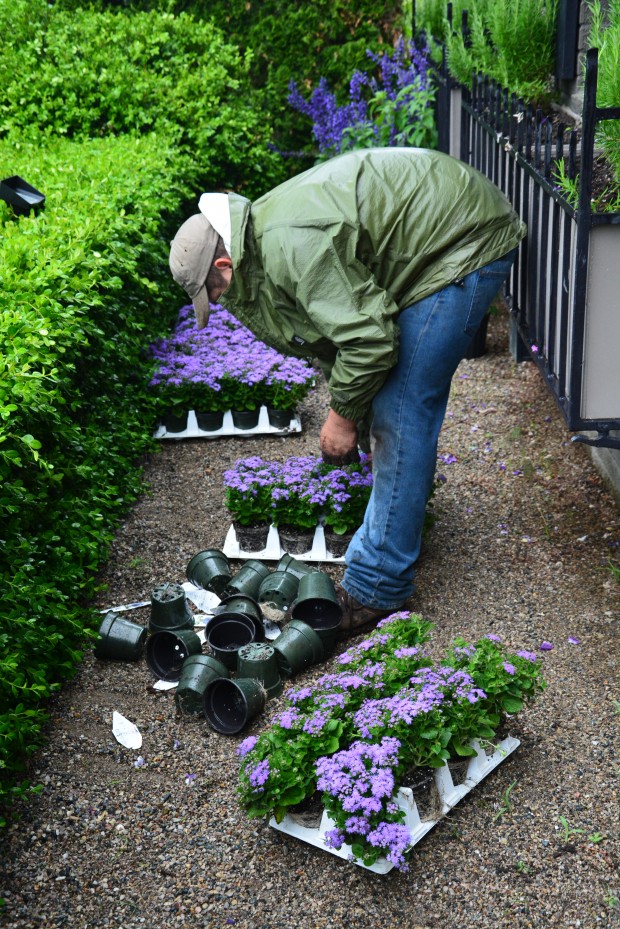
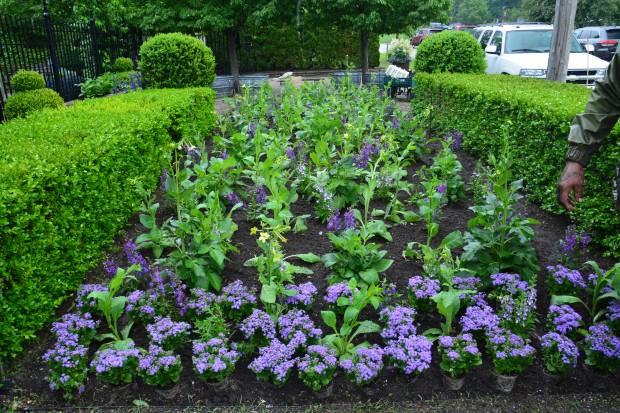 Last year’s scheme was all green. I planted panicum grass inside the boxwood. More than a few customers said it looked like we were going out of business, as we had not cut the grass. Like I say, everyone has a different idea of beautiful. I knew I wanted to do something with purple. The color of this ageratum artist is so luscious. It is a light blue/purple that I call heliotrope blue. Lots of blue with a big dose of lavender. Dark purple has a way of turning dull, if it does not have lively companions. The blue salvia mystic spires has gorgeous blue/purple flowers that are so striking up close. Plant it in a garden, and the color sinks into the background. In the mid and background of this picture, you can barely make out the purple angelonia.
Last year’s scheme was all green. I planted panicum grass inside the boxwood. More than a few customers said it looked like we were going out of business, as we had not cut the grass. Like I say, everyone has a different idea of beautiful. I knew I wanted to do something with purple. The color of this ageratum artist is so luscious. It is a light blue/purple that I call heliotrope blue. Lots of blue with a big dose of lavender. Dark purple has a way of turning dull, if it does not have lively companions. The blue salvia mystic spires has gorgeous blue/purple flowers that are so striking up close. Plant it in a garden, and the color sinks into the background. In the mid and background of this picture, you can barely make out the purple angelonia.

